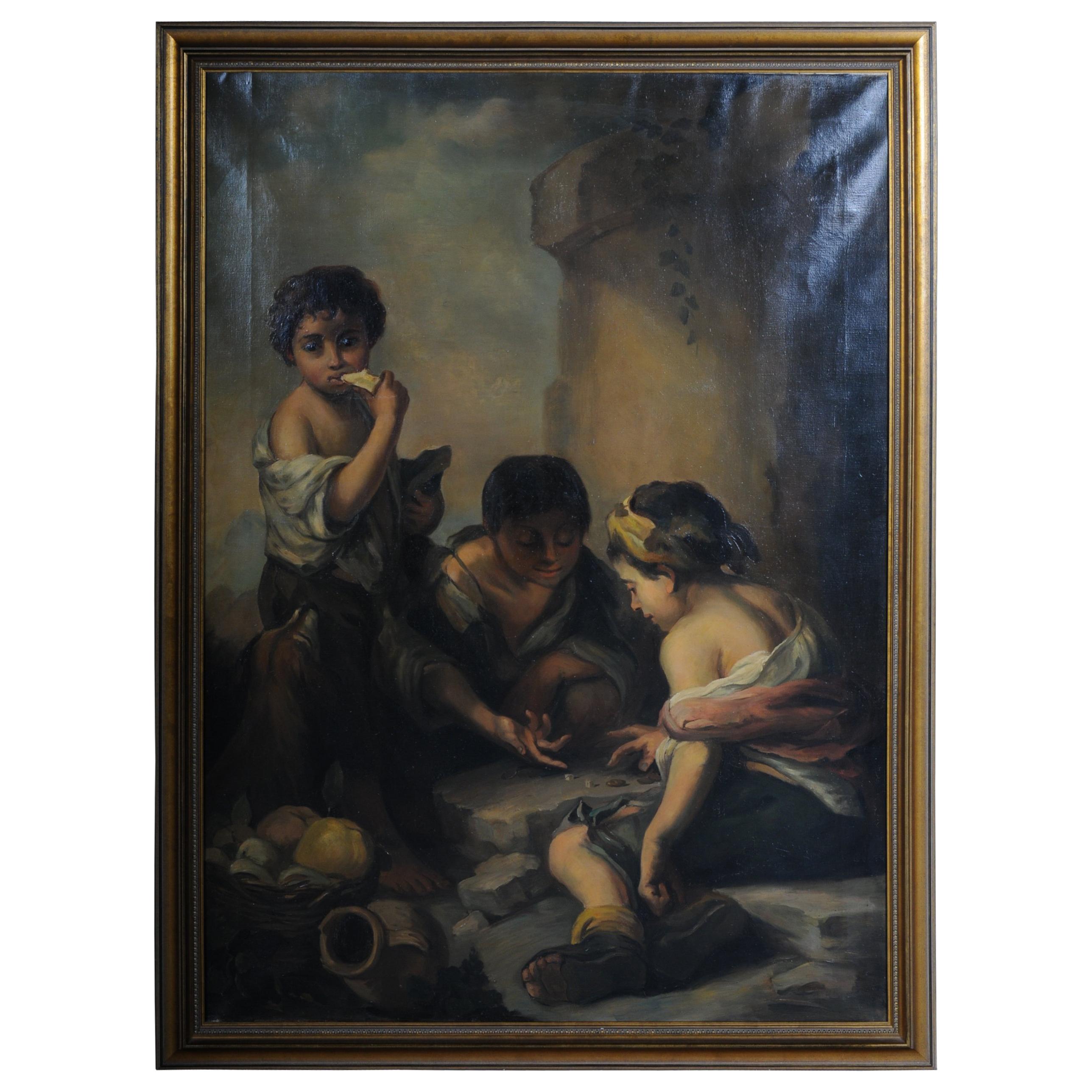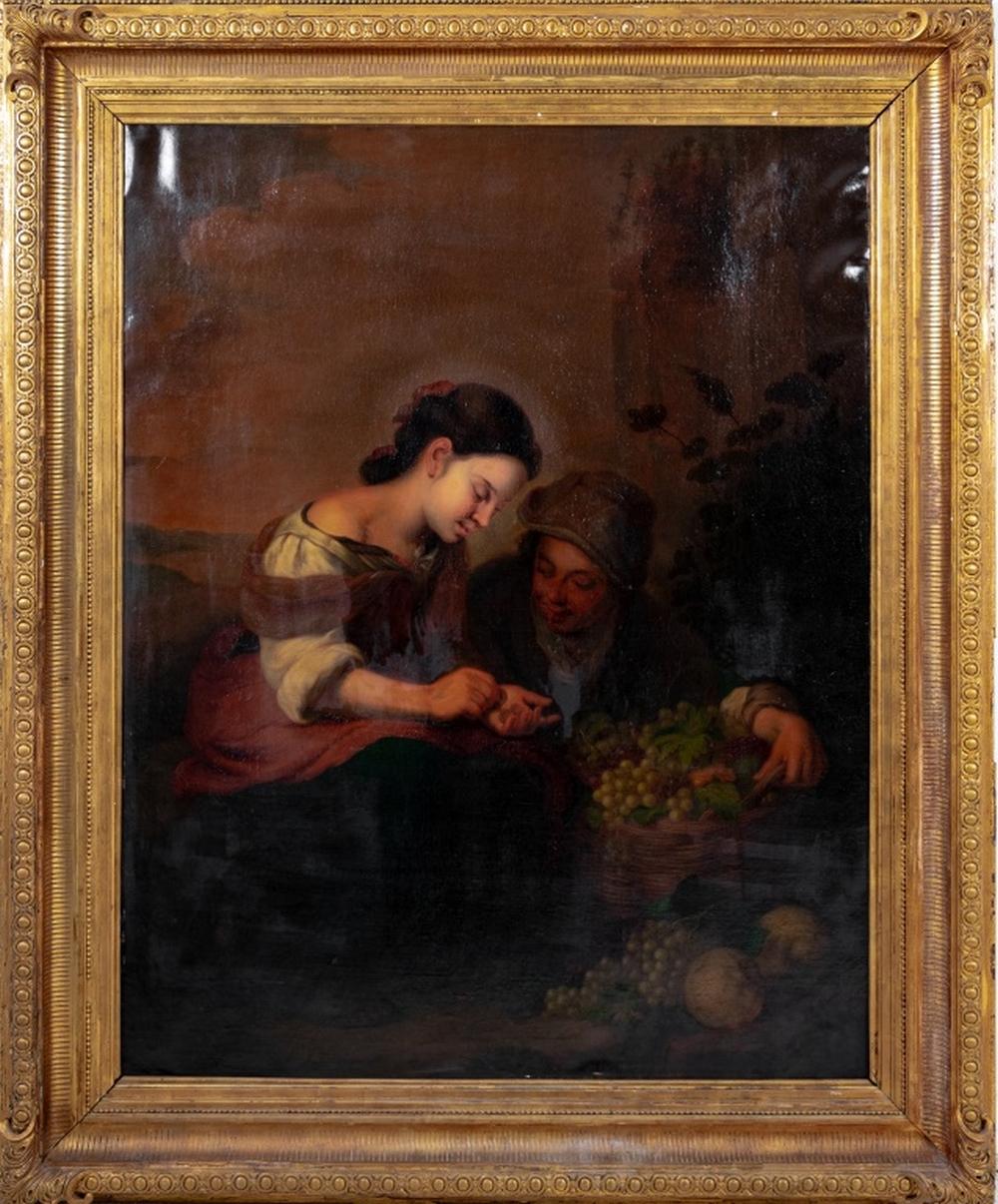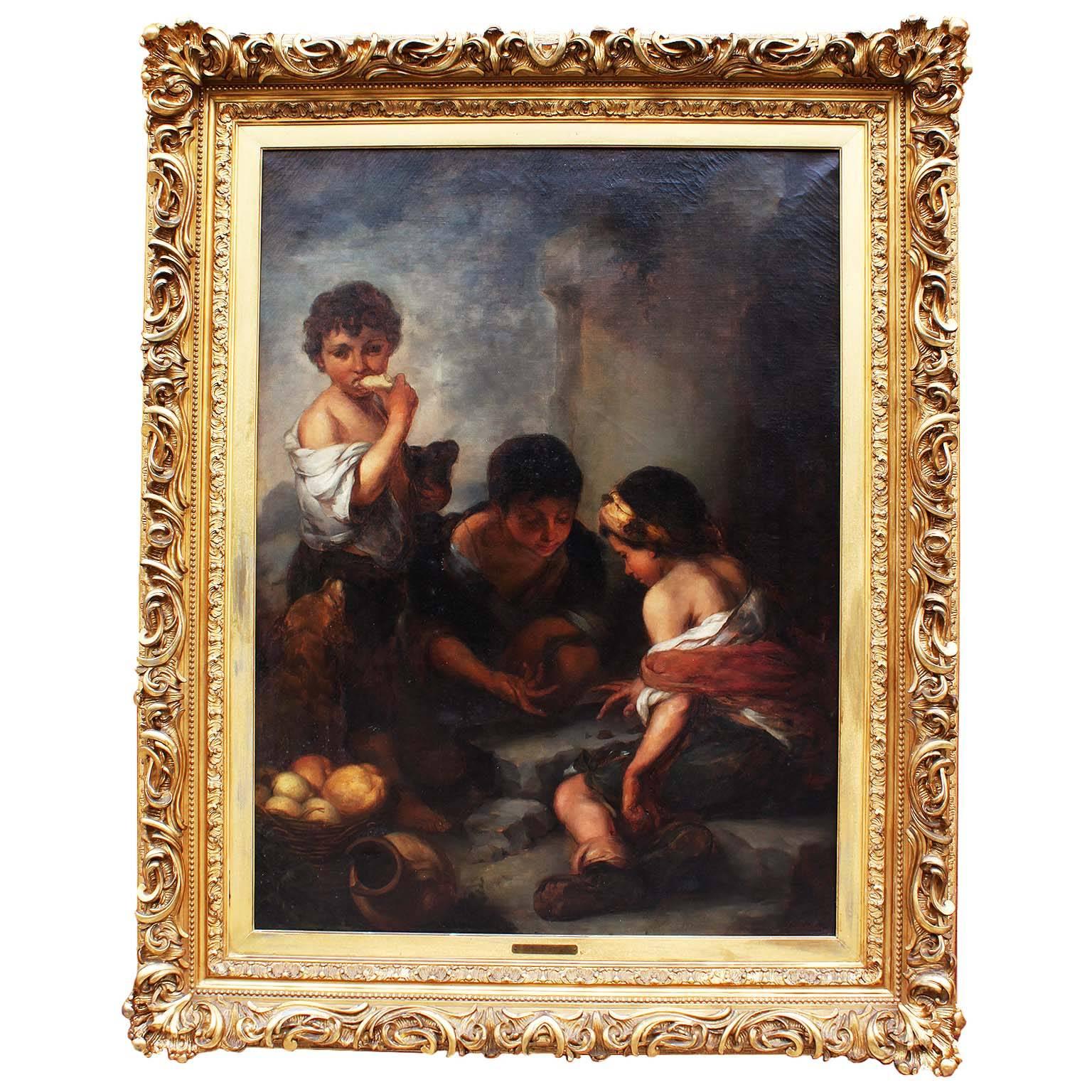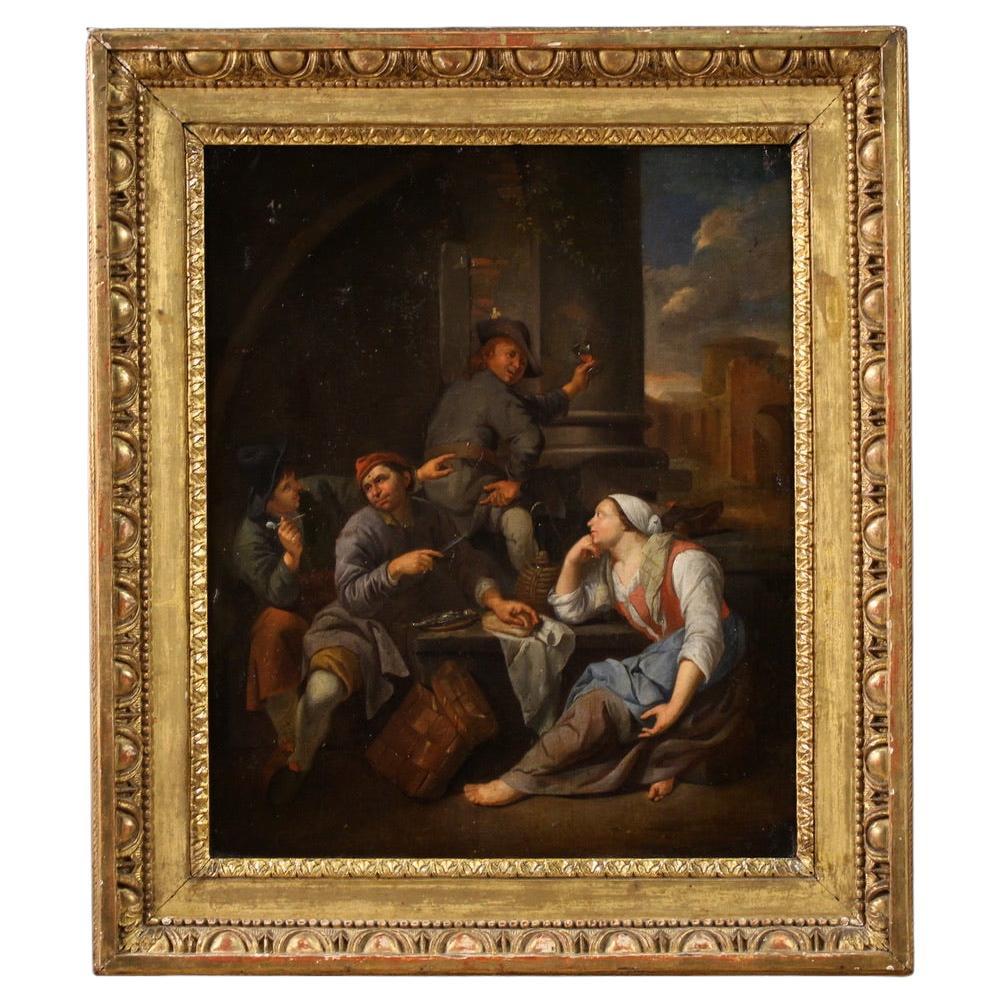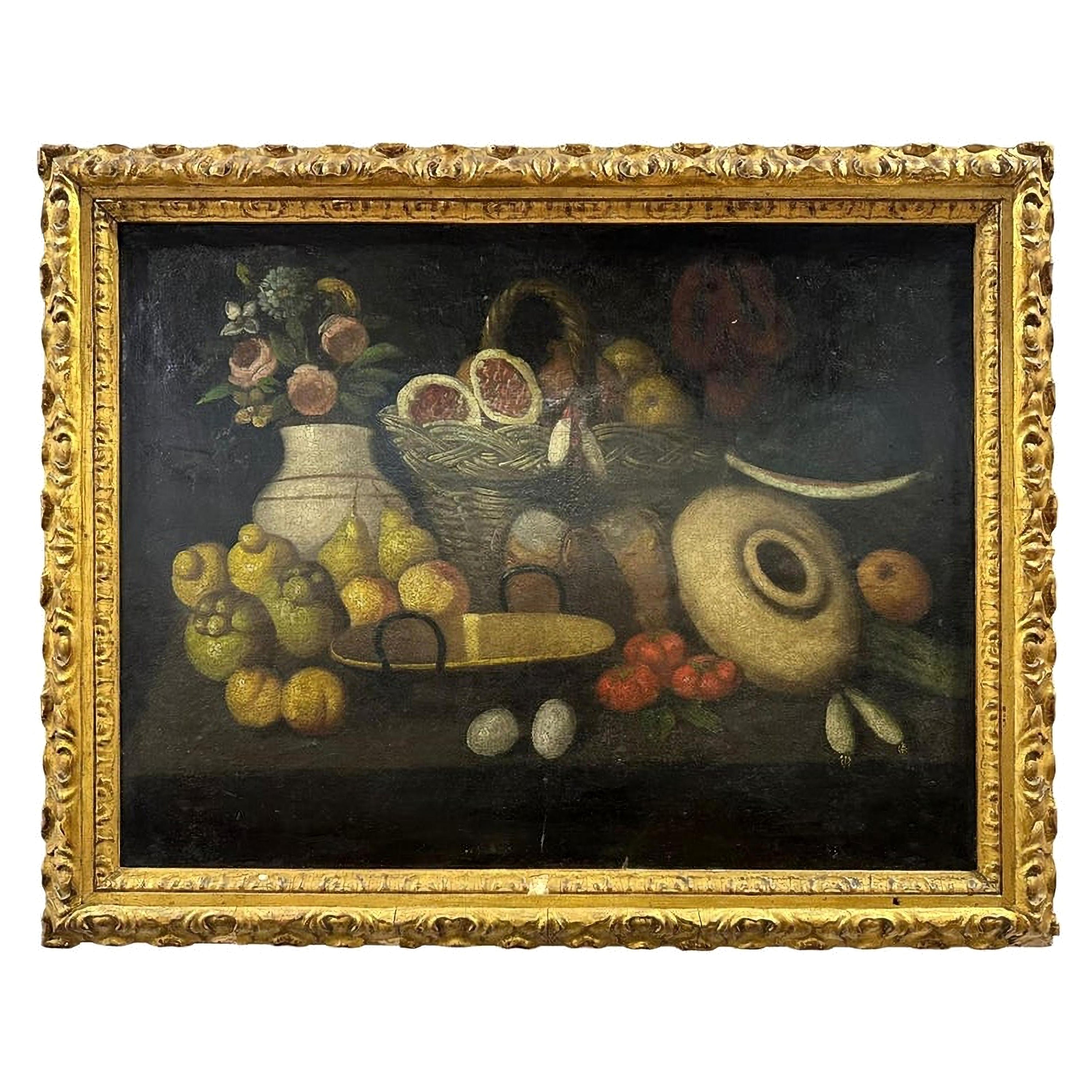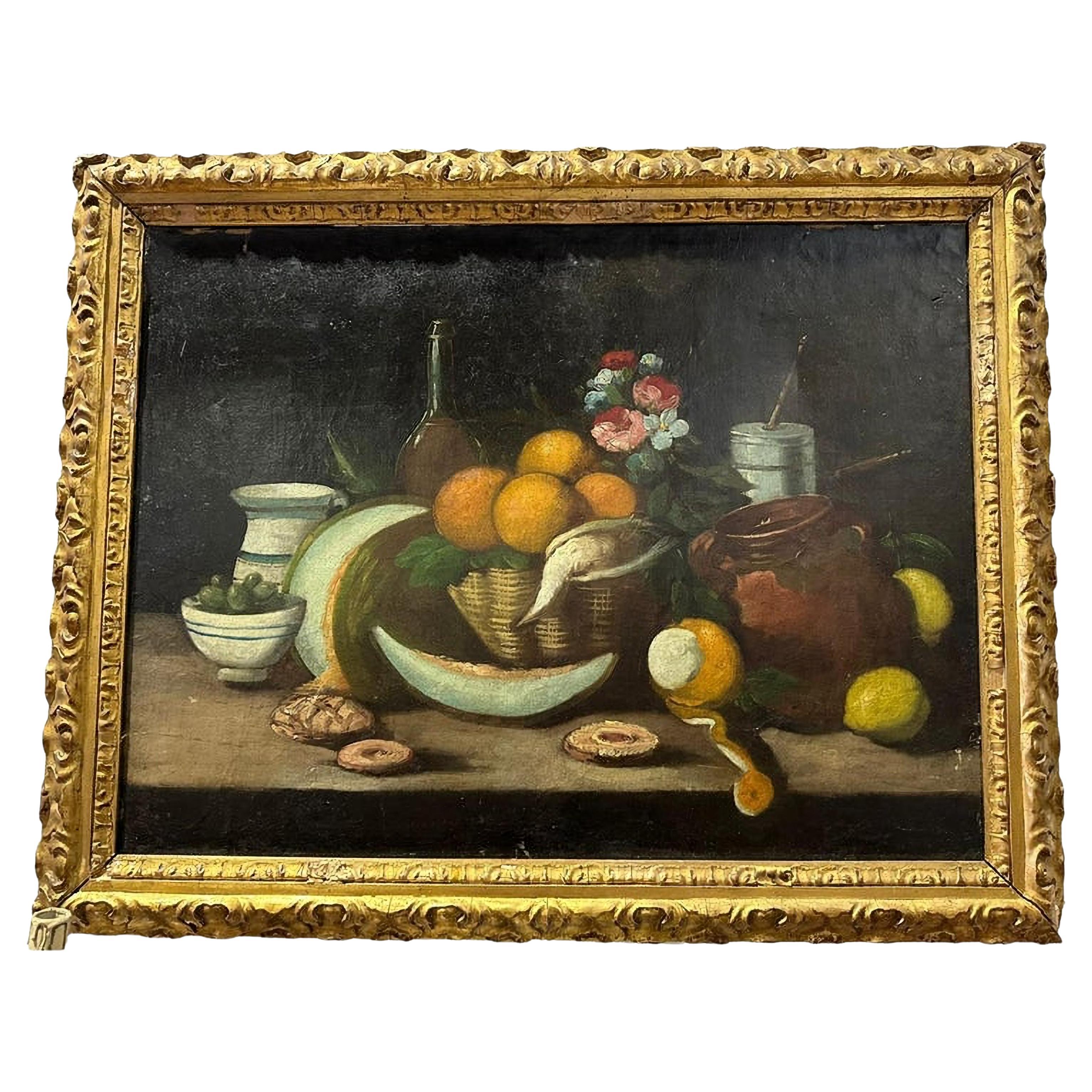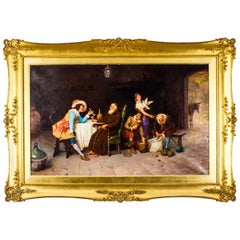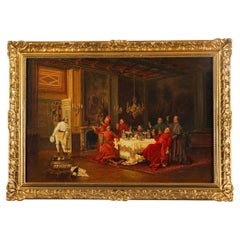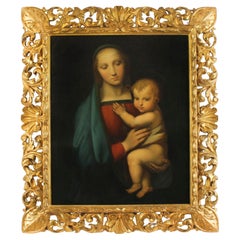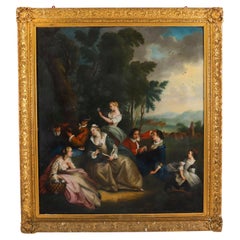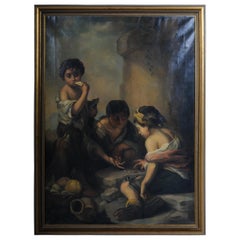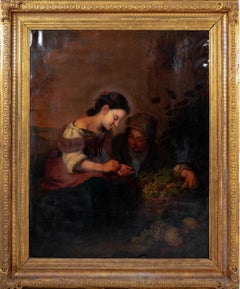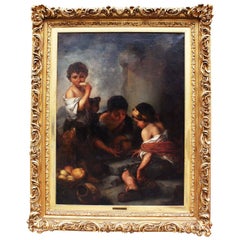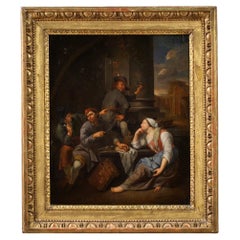Items Similar to Antique Painting Grape and Melon Eaters After Bartolome' Murillo 18th Century
Want more images or videos?
Request additional images or videos from the seller
1 of 14
Antique Painting Grape and Melon Eaters After Bartolome' Murillo 18th Century
$4,473.35
£3,250
€3,809.52
CA$6,106.98
A$6,793.76
CHF 3,561.37
MX$83,018.09
NOK 45,349.66
SEK 42,690.43
DKK 28,436.65
Shipping
Retrieving quote...The 1stDibs Promise:
Authenticity Guarantee,
Money-Back Guarantee,
24-Hour Cancellation
About the Item
This is a delightful antique Spanish oil on canvas painting after Bartolome' Esteban Murillo, depicting two peasant boys eating grapes and melon, Circa 1780 in date.
It features a dog staring at two seated boys while they eat fruit with a basket of fruit in the foreground. This lively realist portrait of street urchins constitutes an appealing record of everyday life at that time.
This superbly accomplished painting is executed in the style of Murillo's later works where he continued to evolve to the very end. In the last decade of his life, Murillo took Rubens's lesson even closer to heart, during this period his brushwork became looser and more visible than ever before, sometimes even to the point that the canvases appear unfinished.
Murillo also reduced his palette to the more sober hues of mauve, grey, brown, and carmine, making his late style more refined than in any previous period.
His style of painting the street children of his native Seville was unprecedented. He employed great naturalism, employing a sombre palette and strong chiaroscuro, contrasting lights and darks, and very little background detail. They are caught, like a photographic snapshot, playing or eating, but are very rarely aware of an onlooker.
This magnificent painting is housed in its original gilded frame surmounted by a pierced cresting rail of scrolling foliage.
It is beautifully executed and as such would make a lovely addition to your collection.
Condition:
In really excellent condition the painting and frame having been beautifully cleaned, please see photos for confirmation.
Dimensions in cm:
Height 73 cm x Width 61 cm - Painting
Height 95 cm x Width 72 cm x Depth 6 cm - Frame
Dimensions in inches:
Height 2 foot, 5 inches x Width 2 foot - Painting
Height 3 feet, 1 inch x Width 2 foot, 4 inches x Depth 2 inches - Frame
Bartolomé Esteban Murillo
Bartolomé Esteban Murillo, (baptized January 1, 1618, Sevilla, Spain—died April 3, 1682, Sevilla), the most popular Baroque religious painter of 17th-century Spain, noted for his idealized, sometimes precious manner. Among his chief patrons were the religious orders, especially the Franciscans, and the confraternities in Sevilla (Seville) and Andalusia.
Among Murillo’s earliest works is the Virgin of the Rosary (c. 1642). In the vestigial style of his artistically conservative Sevillian master, Juan del Castillo, this early work combines 16th-century Italian Mannerism and Flemish realism. The 11 paintings that originally hung in the small cloister of San Francisco in Sevilla—e.g., the Ecstasy of St. Diego of Alcalá (1646)—are executed in the more contemporary naturalistic style of the Sevillian school, established by Diego Velázquez and continued by Francisco de Zurbarán. That series is characterized by realism and tenebrism (contrasting light and shade) and use of commonplace models, with an emphasis on genre or scenes of everyday life.
In the 1650s a striking transformation of style occurred, usually attributed to a visit to Madrid, where Murillo undoubtedly met Velázquez and studied the works of Titian, Peter Paul Rubens, and Anthony van Dyck in the royal collections. The softly modeled forms, rich colours, and broad brushwork of the 1652 Immaculate Conception reflect direct visual contact with the art of the 16th-century Venetians and the Flemish Baroque painters. The St. Leandro and St. Isidoro (1655) are even further removed from the simple naturalism of his earlier Franciscan saints. These seated figures, more than life size, are in the grand manner of Baroque portraiture, which had become fashionable at the Spanish court.
The Vision of St. Anthony (1656), one of Murillo’s most celebrated pictures, is an early example of his so-called “vaporous” style, which was derived from Venetian painting. In 1660 Murillo was one of the founders and first president of the Academy of Painting in Sevilla. During the two following decades he executed several important commissions, generally representing dramatized genre on a grand scale. From 1678 onward Murillo worked on another series of paintings, for the Hospicio de Venerables Sacerdotes in Sevilla, which included the celebrated Soult Immaculate Conception (1678), which was removed to France by Nicolas-Jean de Dieu Soult during the Napoleonic period.
Although Murillo’s subjects were often religious, he also produced many genre paintings of ordinary contemporary life. He depicted the street children of Seville in Grape and Melon Eaters (c. 1645) and glimpses of the aristocracy from the street in Two Women at a Window (c. 1655/1660). Murillo’s late style is exemplified by his unfinished works for the Capuchin church at Cádiz and The Heavenly and Earthly Trinities (c. 1675–82; popularly called the “Holy Family”). The often mystical significance of his subjects is countered by the idealized reality of his figures based on familiar human archetypes, with natural gestures and tender, devout expressions, creating an effect of intimate rather than exalted religious sentiment.
Murillo had many pupils and innumerable followers. His paintings were copied and imitated throughout Spain and its empire. He was the first Spanish painter to achieve widespread European fame, and until the 19th century he was the only Spanish artist whose works were extensively known outside the Hispanic world.
Our reference: A2853a
- Similar to:Bartolomé Esteban Murillo (Painter)
- Dimensions:Height: 37.41 in (95 cm)Width: 28.35 in (72 cm)Depth: 2.37 in (6 cm)
- Style:Baroque (In the Style Of)
- Materials and Techniques:
- Place of Origin:
- Period:
- Date of Manufacture:circa 1780
- Condition:
- Seller Location:London, GB
- Reference Number:Seller: A2853a1stDibs: LU950643079162
About the Seller
5.0
Platinum Seller
Premium sellers with a 4.7+ rating and 24-hour response times
Established in 1983
1stDibs seller since 2012
1,374 sales on 1stDibs
Typical response time: <1 hour
Associations
LAPADA - The Association of Arts & Antiques Dealers
- ShippingRetrieving quote...Shipping from: London, United Kingdom
- Return Policy
Authenticity Guarantee
In the unlikely event there’s an issue with an item’s authenticity, contact us within 1 year for a full refund. DetailsMoney-Back Guarantee
If your item is not as described, is damaged in transit, or does not arrive, contact us within 7 days for a full refund. Details24-Hour Cancellation
You have a 24-hour grace period in which to reconsider your purchase, with no questions asked.Vetted Professional Sellers
Our world-class sellers must adhere to strict standards for service and quality, maintaining the integrity of our listings.Price-Match Guarantee
If you find that a seller listed the same item for a lower price elsewhere, we’ll match it.Trusted Global Delivery
Our best-in-class carrier network provides specialized shipping options worldwide, including custom delivery.More From This Seller
View AllAntique Oil on Canvas Painting by Francesco Bergamini 19th Century
By Francesco Bergamini 1
Located in London, GB
This is a truly splendid antique oil on canvas painting featuring a period interior scene by Francesco Bergamini (1851-1900) Italian, signed and dated 1894.
This beautiful oil pai...
Category
Antique 1890s Italian Paintings
Materials
Canvas, Giltwood
Antique Oil Painting "The Toast" after Francesco Brunnery 19th Century
Located in London, GB
This is a magnificent antique Italian oil on canvas painting of a group of Cardinals in the style of Francesco Brunnery, (Italian 1845-1929), circa 1890 in date.
This beautiful pain...
Category
Antique Late 19th Century Italian Paintings
Materials
Canvas
Antique Painting Madonna & Child 'Paoletti and Ferretti' 19th Century
Located in London, GB
This is a beautiful oil on canvas painting after Raphael, depicting the Madonna and Child in the original giltwood Florentine frame, Circa 1880 in date.
It bears a label to the reve...
Category
Antique 1880s Paintings
Materials
Giltwood
Antique Oil on Canvas Painting "Party Picnicking" After Watteau 18th Century
By Jean-Antoine Watteau
Located in London, GB
This is a large delightful antique oil on canvas painting after Watteau, depicting a "Party Picnicking", Circa 1780 in date.
The painting depicts a group of people relaxing in the c...
Category
Antique Late 18th Century Paintings
Materials
Canvas
Antique Painting Our Lady of The Rosary After Bartolomé Murillo 19th Century
By Bartolomé Esteban Murillo
Located in London, GB
A large Spanish oil on canvas of Our Lady of The Rosary after Bartolomé Esteban Murillo, early 19th century in date.
It features the Virgin Mary holding baby Jesus in her arms, she...
Category
Antique Early 1800s Spanish Paintings
Materials
Canvas
Antique Oil Painting "Sacrifice to Minerva" Odoardo Vicinelli Letterfourie 18thC
Located in London, GB
A large antique oil on canvas painting entitled "Sacrifice to Minerva", circle of Francesco Solimena, attributed to Odoardo Vicinelli, dating from the mid 18th Century.
The painting depicts a man standing, behind an altar, shielding himself from a kindling fire. To the left of the altar is seated Minerva, in classical flowing white robes, surrounded by a crowd of people.
Francesco Solimena (4 October 1657 – 3 April 1747) was a prolific Italian painter of the Baroque era, one of an established family of painters and draughtsmen.
Verso: Title, describtion, inventory marks and later restoration stamp: Aitken Dott & Son, Edinburgh 15 July 1970.
Also bears an inscription attributing the painting to Odoardo Vicinelli:
Odoardo Vicinelli, scholar of Giovanni Maria Morandi, flourished about 1750
an excellent master of the Venetian and Roman Schools,
Provenance:
Formerly at Letterfourie, Morayshire, and by descent, through the Gordon family
Letterfourie House is a Georgian house in Moray Scotland, built by Robert Adam and completed in 1773 for Clan Gordon...
Category
Antique 1750s Italian Paintings
Materials
Canvas
You May Also Like
Great Painting Grapes and Melon Eaters After Esteban Murillo Oil of Canvas
By Bartolomé Esteban Murillo
Located in Berlin, DE
The picture shows two about ten-year-old street boys eating fruit. The environment is not further defined. With obvious pleasure, the left street boy is eating a grape while the righ...
Category
20th Century European Paintings
Materials
Canvas
After Bartolome Murillo "Little Fruitseller" Oil
By (After) Bartolomé Esteban Murillo
Located in Astoria, NY
After Bartolome Esteban Murillo (Spanish, 1618-1682), "The Little Fruitseller", Oil on Canvas, 19th century, apparently unsigned, depicting young girl and boy counting money over var...
Category
19th Century Old Masters Figurative Paintings
Materials
Oil
$2,240 Sale Price
20% Off
Large Oil on Canvas "Beggar Boys Playing Dice" After Bartolomé Esteban Murrillo
By Bartolomé Esteban Murillo
Located in Los Angeles, CA
A fine and large 19th century oil on canvas after Bartolomé Esteban Murrillo's (Spanish, 1617-1682) "Beggar Boys Playing Dice" (The original work by Murillo was painted in 1675). The impressive artwork depicts two young boys playing dice while another eats a piece of fruit as his dog watches on., within an ornate gildwood and gesso frame bearing a label from the faming company Bigelow & Jordan. The original work by Murillo is currently at the Alte Pinakothek Museum in Munich, Germany. The present work is signed: L. Rüber. Circa: Munich, Late 19th Century.
Bartolomé Esteban Murillo (born late December 1617, baptized January 1, 1618 – April 3, 1682) was a Spanish Baroque painter. Although he is best known for his religious works, Murillo also produced a considerable number of paintings of contemporary women and children. These lively, realist portraits of flower girls, street urchins, and beggars constitute an extensive and appealing record of the everyday life of his times.
Murillo was born to Gaspar Esteban and María Pérez Murillo. He may have been born in Seville or in Pilas, a smaller Andalusian town. It is clear that he was baptized in Seville in 1618, the youngest son in a family of fourteen. His father was a barber and surgeon. His parents died when Murillo was still very young, and the artist was largely brought up by his aunt and uncle.
Murillo began his art studies under Juan del Castillo in Seville. There he became familiar with Flemish painting and the "Treatise on Sacred Images" of Molanus (Ian van der Meulen or Molano). The great commercial importance of Seville at the time ensured that he was subject to influences from other regions. His first works were influenced by Zurbarán, Jusepe de Ribera and Alonzo Cano, and he shared their strongly realist approach. As his painting developed, his more important works evolved towards the polished style that suited the bourgeois and aristocratic tastes of the time, demonstrated especially in his Roman Catholic religious works.
In 1642, at the age of 26, he moved to Madrid, where he most likely became familiar with the work of Velázquez, and would have seen the work of Venetian and Flemish masters in the royal collections; the rich colors and softly modeled forms of his subsequent work suggest these influences. In 1645 he returned to Seville and married Beatriz Cabrera y Villalobos, with whom he eventually had eleven children.
In that year, he painted eleven canvases for the convent of St. Francisco el Grande in Seville. These works depicting the miracles of Franciscan saints vary between the Zurbaránesque tenebrism of the Ecstasy of St Francis and a softly luminous style (as in Death of St Clare...
Category
Antique Late 19th Century German Baroque Paintings
Materials
Gesso, Canvas, Wood
$14,850 Sale Price
40% Off
18th Century Oil on Canvas Flemish Antique Painting Genre Scene, 1770
Located in Vicoforte, Piedmont
Refined Flemish painting from the 18th century. Oil on canvas artwork depicting a lively genre scene, of notable pictorial quality and rich in minute details. In a rustic setting, pr...
Category
Antique 1770s Dutch Paintings
Materials
Canvas
Spanish School STILL NATURES " Bodegones " 17th Century
Located in Madrid, ES
Spanish School STILL NATURES " Bodegones " 17th Century
Oil on canvas,
spanish school
Screen cleaning performed
Dim.: 60 x 80 cm
good conditions
Category
Antique 17th Century Spanish Baroque Paintings
Materials
Paint
Spanish School STILL NATURES " Bodegones " 17th Century
Located in Madrid, ES
Spanish School STILL NATURES " Bodegones " 17th Century
Oil on canvas,
spanish school
Screen cleaning performed
Dim.: 60 x 80 cm
good conditions
Category
Antique 17th Century Spanish Baroque Paintings
Materials
Paint
More Ways To Browse
Immaculate Conception
Spanish Andalusia
Dog Eat Dog
Antique Italian Rosary
18th Century Antique Rosary
Window Seat Empire
King Headboard With Nightstands
Orange Travertine
Pagoda Model
Paradise Of Bird Glass
Paris Flea Market
Patina Iron Bed
Pearl Inlay Chest
Plum Pudding Mahogany
Postmodern Bed
Pottery Face Italian
Prayer Altar
Regency China Cabinet
